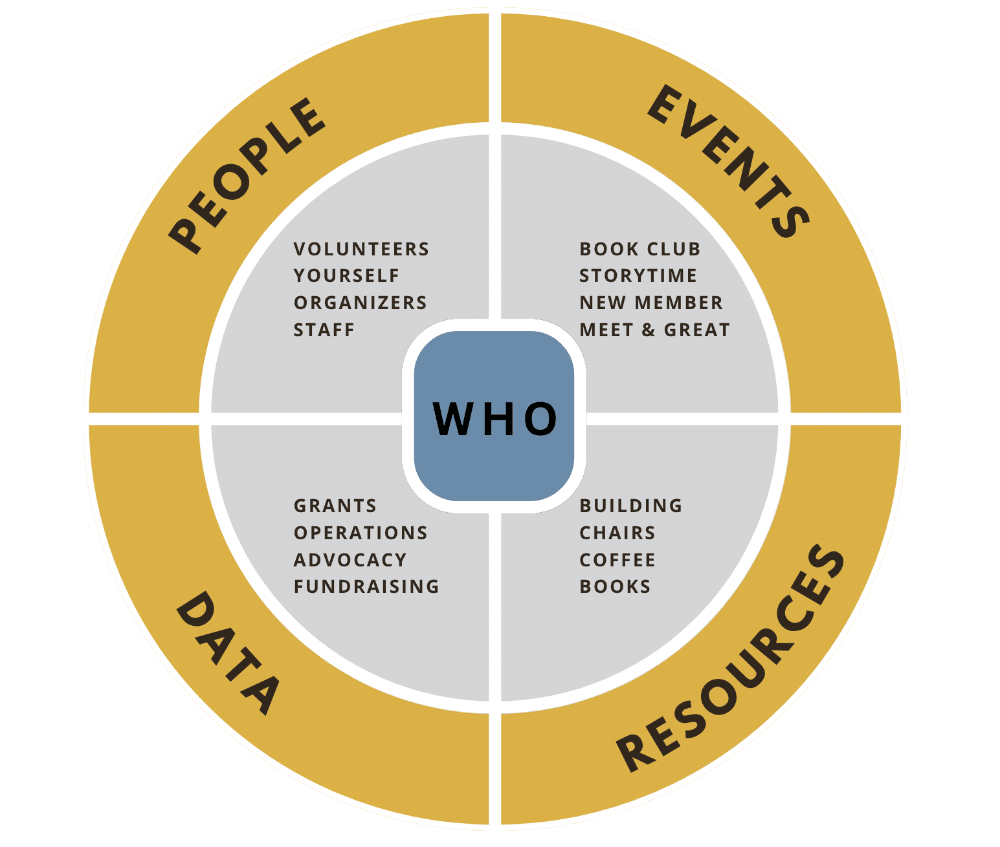Thriving Community Space Framework
The Thriving Community Space Framework provides a clear, actionable plan for leaders of public places like libraries, parks, and museums to increase their community impact and engagement. It is designed for any community space manager who wants to see their facility better attended, funded, and valued by the people they serve. By focusing on four key levers—Events, People, Data, and Resources—this framework helps you connect with your audience and build a vibrant, sustainable community hub.

Who
At the very heart of your organization are your mission, your values, and the specific people you exist to serve. It is essential to clearly define and communicate your purpose, ensuring there is no ambiguity about your intended audience. Answering the fundamental questions of “Who’s it for?”, “What’s it For?” and “Why should they care?” is the critical first step to building a space where your community feels they truly belong.
The 4 Levers
There is a lot to running a community space and keeping a community connected. We’ve categorized these into the 4 aspects that all community spaces have in common. We call these different aspect, the 4 Levers. The 4 Levers are Events, Resources, Data, and People.
Events and Promotion
This section covers the activities that you do to engage with your community and let others know that you exist. For most community spaces, the main way that they attract new members is by having events, and asking their existing community members to invite someone to an event. In this section we’ll discuss advocacy, promotion, connection, and other topics related to getting new members in the door. People often need a reason to find your space. And events and advocacy are a great way for them to know about you.
People
There is no such thing as a community space without people. As a community space manager, you’ll interact with members of your community. Some of them will love the community so much that they’ll want to become organizers and do things like host events at your space. Some of them will go beyond that and want to be volunteers at your space and do even more. Some of them will be your paid employees. And finally there is you, the space manager, or owner. This section will cover how to handle the different types of people you’ll interact with.
Data
Growing Community Spaces need data to make the right decisions. In this section we’ll cover the information that is helpful to track to help manage the space, present to boards, ask for funding, and check your finances to make sure that you can keep the lights on.
Resources
This section covers resources that you provide to members of your community. These are the items most people think of when they think of a space. For example, for a library, these would be their collections, their building, their rooms. For a park, this might be an open space, or playground equipment. For a maker space, this might be CNC machines, or 3d printers.
Benefits of Using the Framework
-
Quickly identify the different strengths and weaknesses of running your community space.
-
Have a method for continuous improvement at your community space, identifying areas that can be improved and areas that are already going well.
Work on 1 Lever Per Quarter
It’s hard to do everything at once. But by focusing on one aspect of running a community space each quarter, it ensures that enough time is being spent on the different aspects, without overwhelming the leadership or trying to do everything all at once.
Improvements in 1 Lever Impact the Others
As you improve one aspect of running your community space, you’re likely to see improvements in other areas. So, for example, as you have more events at your space, you might see more people wanting to volunteer. Or as you have better data and are able to apply for grants, this might impact the quality of the resources that you are able to provide. Improving each aspect of a community space is important on it’s own, but really by improving each lever, all aspects of running the community space should start to be positively impacted.
Schedule a Demo with WhoFi and see of our all-in-one suite of services in action!
Understanding the framework is the first step; having the right tools to implement it is the game-changer. We created WhoFi to bridge that gap, building our platform on the core principles of successful Events, easy to manage Resources, insightful Data, and connected People. Instead of juggling disconnected systems, you can finally manage everything in one place and focus on what you do best—serving your community.
